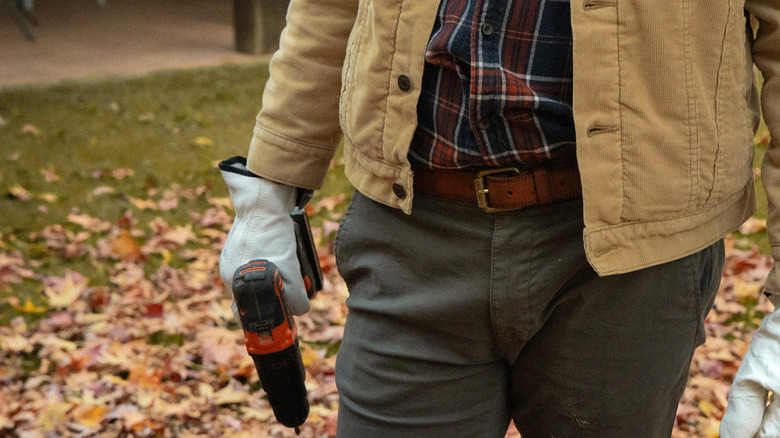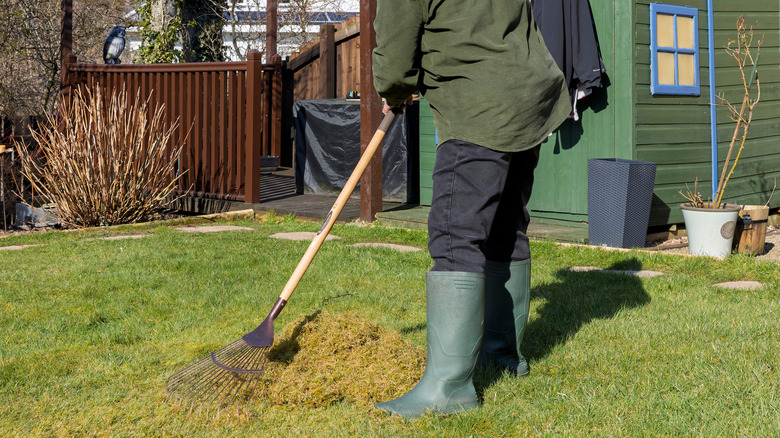How To Fix A Patchy Lawn Without Using Expensive Tools
If you're living through a patchy lawn predicament, it could be caused by several factors. Chemical spills, too many people or pets walking around on your lawn — or in the case of the aforementioned pets, urine — infestations, fungal diseases, poor soil conditions, or a combination of factors can all be culprits. In the latter case, compacted soil particles leading to poor soil quality can be the result of too much foot traffic. When the soil is too compacted, it constricts water and oxygen in the soil making it difficult to grow anything in that area. Hence, patches in your lawn.
If your lawn looks unloved because of bald patches in an otherwise well manicured lawn, a cordless drill provides a solution. It's an inexpensive way to make your lawn more fab than drab and won't require you to run out and purchase any pricey new tools. Even better, as just one of those tools every homeowner should own, any regular reader of House Digest likely already owns one. While a core aerator — a tool that breaks up soil particles and removes soil plugs — is the usual answer for spotty lawns, a quick search reveals a professional quality aerator could cost you north of $5,000. According to Lawn Love, the national average cost of hiring a company to aerate your lawn is $143, with homeowners spending as much as $496, while renting a core aerator will cost around $100 per day.
Here's how to aerate your lawn with a common household tool
So long as your goal is to create more breathing room for your soil, a drill is your best, least expensive option. That said, it's not particularly a good way to remove soil plugs from the earth, so if that's your goal, consider more traditional ways to aerate your lawn for healthier grass. For an easy fix, employ a cordless drill with a strong enough bit to power about ½ inch deep holes in your soil inside the patchy bits of your lawn. Drill a large number of holes, evenly spread around your patchy areas. This should require very little elbow grease to accomplish. This process breaks up the soil and creates new pathways for water, sunlight, essential nutrients, and oxygen to reach your seeds. Consider this a budget-friendly DIY way to aerate your lawn for less.
Once you're done creating new space, it's time to cover those spaces with a uniform layer of grass seed. Once you're done layering your patch, add another even, but shallow layer of topsoil. Although you would normally seed your lawn in later summer months like August to September, you should get on with seeding immediately if you notice patches. If you don't own a drill, consider trying out one of these four top-rated drills to tackle any household project.
This common lawn tool is another quick fix
A rake is a common garden tool that most people use to collect leaves in fall. It's also a relatively inexpensive tool you can purchase from stores like Home Depot for less than $15. If you decide to use this method instead of using a drill to break up your soil, you should rake along the exposed soil patches between the grass on your lawn. Aside from enhancing the ability of soil to absorb nutrients and oxygen, it also offers the additional benefits of limiting weeds and moss — raking won't remove all the moss but can remove most of it — and fungal diseases like snow mold, which can leave gray or pink patches in your lawn after particularly long winters. Apply a delicate hand to your raking efforts, but whatever you do, don't rake the ground if it's wet since this actually causes more soil compaction and further damage to grass roots.
Once you're done raking your patch, sprinkle a thick layer of grass seed over the area, followed by a shallow layer of topsoil or compost. If you want to save time, apply a combination of grass seed and top soil or mulch with a lawn repair kit, one of a few ways to repair the thinning grass in your yard. Be sure to water the area every day unless it rains, and if you live in an especially arid region, twice a day is a good goal.


